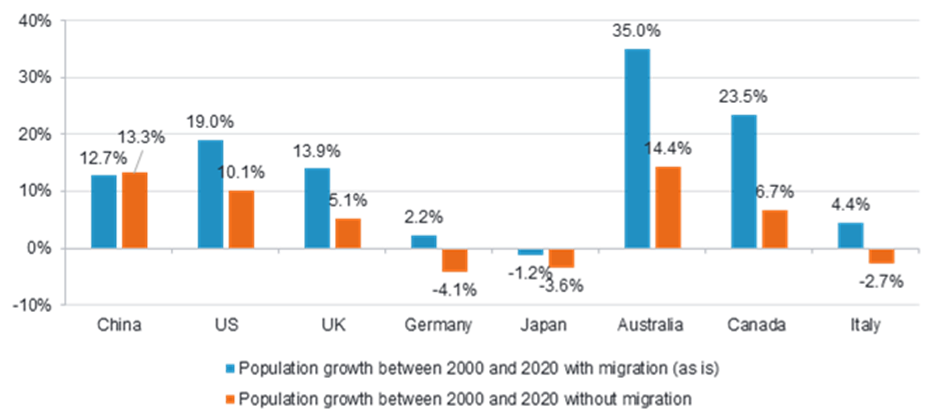Solutions & Multi Asset: Chart of the week
The ageing and shrinking populations of developed markets and China is expected to be a drag on growth in the 21st century. However, there are several ways government policy can try to soften the blow.
Openness to immigration is one way to offset shrinking working age populations

Source: Fidelity International, UN Data, October 2022
Demographic trends in the coming decades are expected to be different from those of the past. The post-WWII baby booms in the US (1946-1964) and later in China (1963-1977) enabled sustained periods of robust economic growth. But this trend is now reversing. The global population is still expanding, driven by frontier economies in South Asia and Africa that will overtake
China as the world’s most populous countries. Yet, the number of working age people in developed markets is set to decline. China’s population, meanwhile, is set to half by the end of the century. We expect the ageing and shrinking of populations in developed markets and China will be a headwind to growth. But there are a few policy options governments can use to mitigate this.
First, as the chart shows, openness to immigration is one way to offset falling fertility rates in developed markets. Australia, Canada, the UK, and the US have benefited the most, while Germany would have seen a population contraction if not for immigration. Immigration also supports growth through other factors. For example, it increases productivity through higher innovation and improved efficiency, in both tails of the skills distribution. In the lower tail, low-cost housekeeping and childcare provided by immigrants into the US have facilitated higher labour participation and hours worked among women in higher paid jobs, thus raising GDP growth. In the upper tail, skilled immigrants in the US in the 1990s accounted for one third of the large increase in patents filed, which in turn led to a 1.4% increase in per capita GDP over the decade.
Second, encouraging more women to work can help to compensate for shrinking working age populations. Japan achieved this, thereby increasing the total size of its workforce, partly as a result of Shinzo Abe’s policies in 2011-2012 to incentivise more women to work. Lastly, life expectancies are increasing across regions, giving governments the option to extend working lives by pushing retirement or pension collection ages, a process already started in numerous countries.
